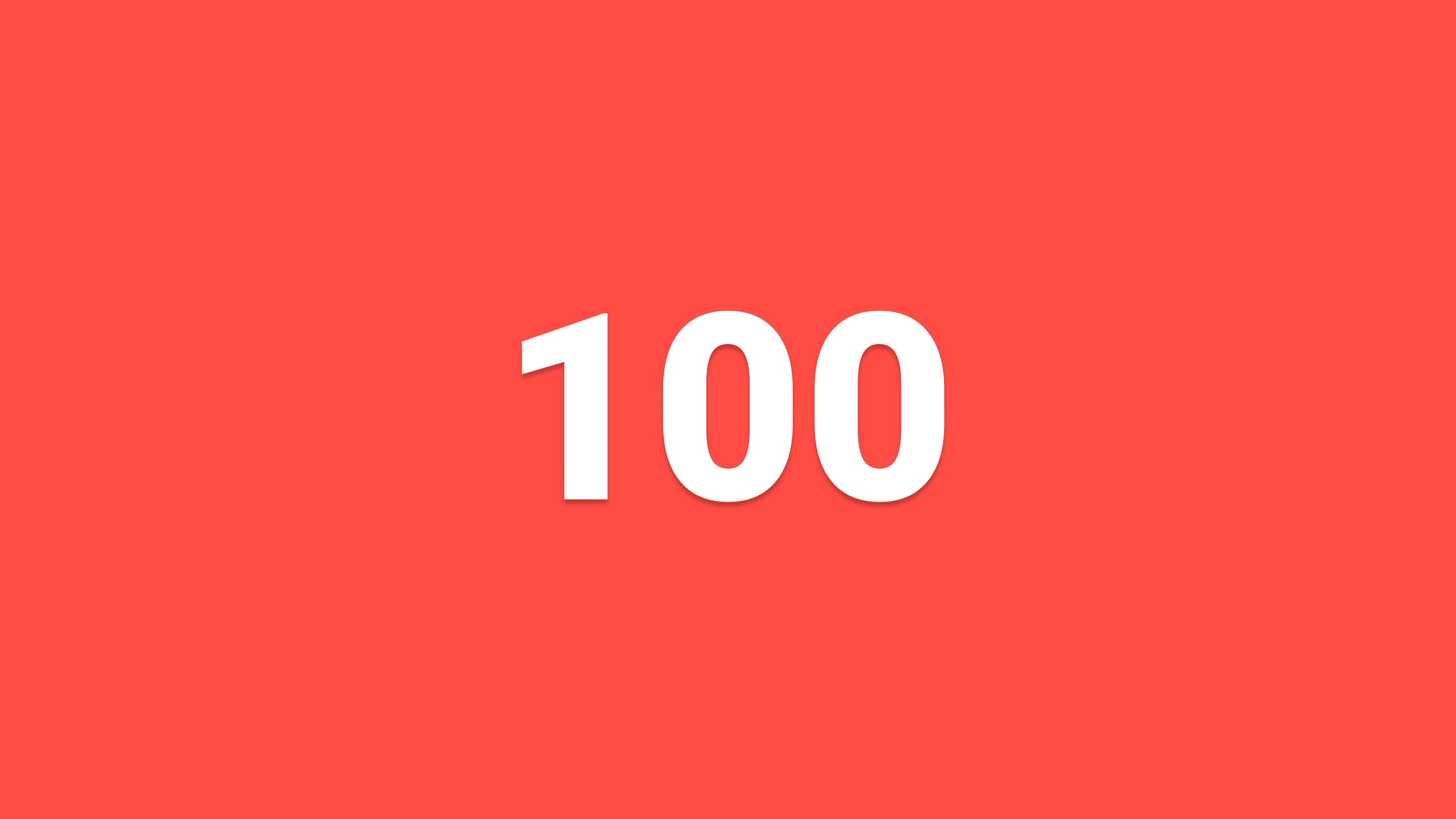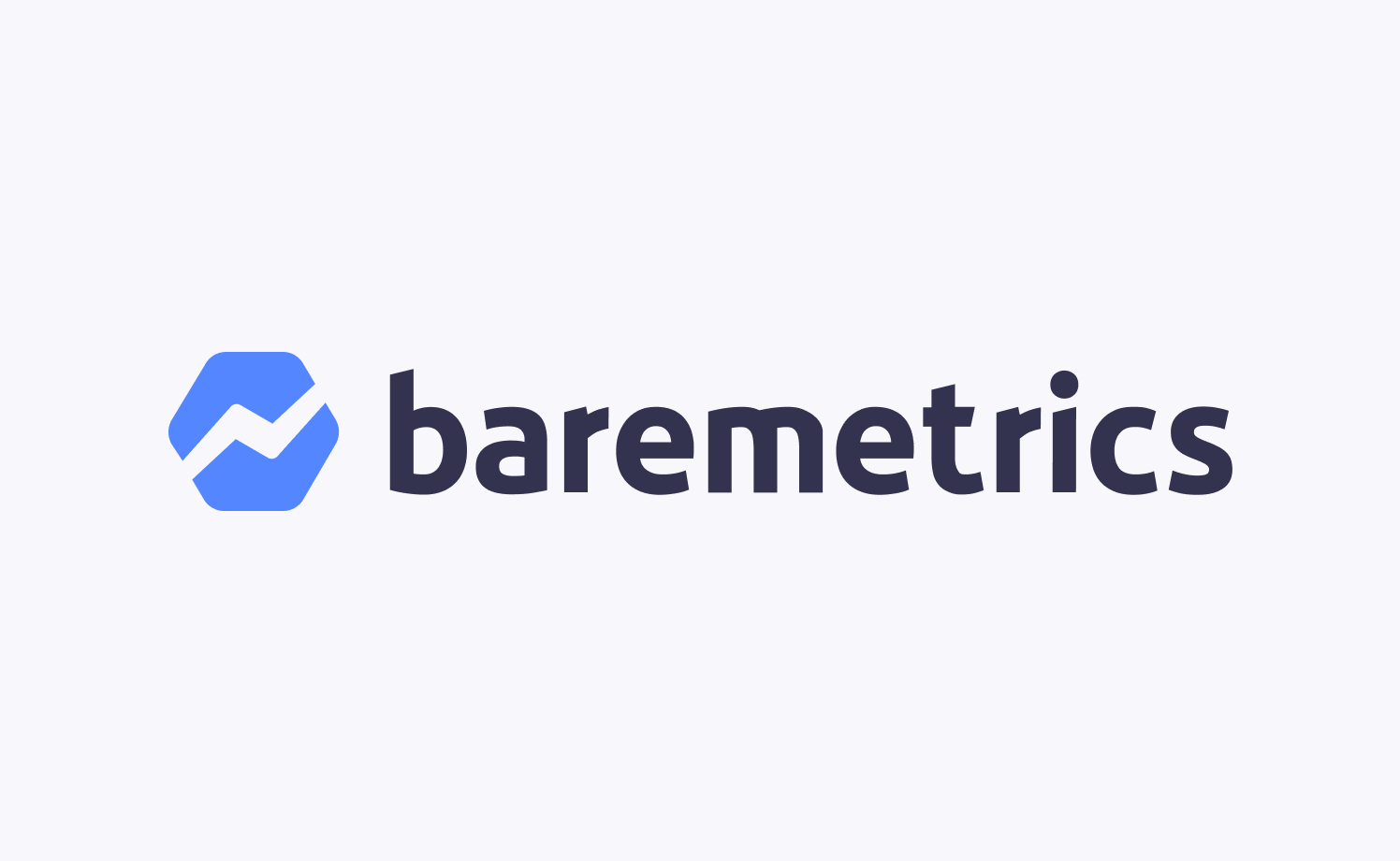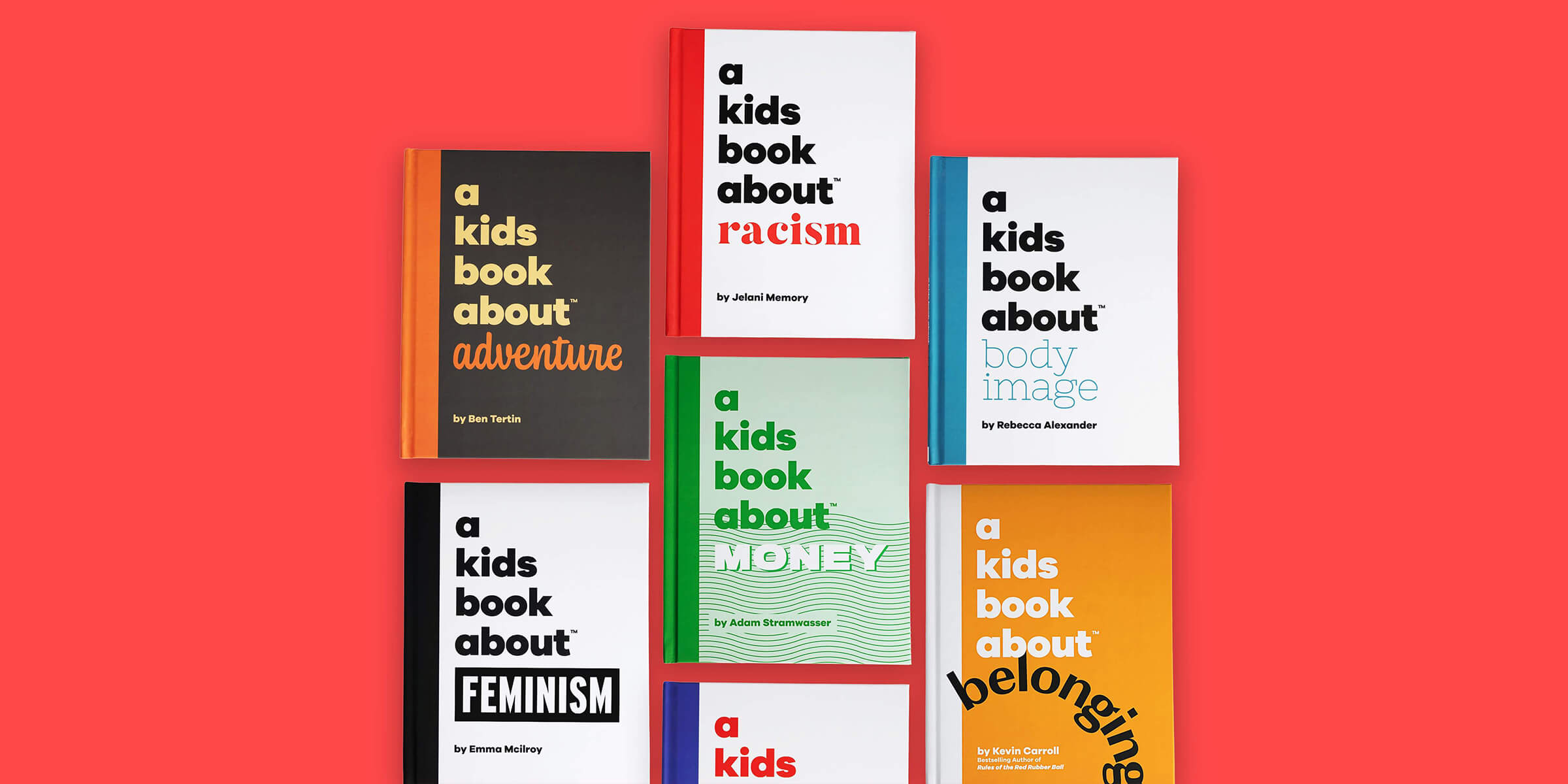Corey Haines: Thank you for having me. Yeah. Super stoked. I've been a listener for a long time. I think back to the kind of OG season. So it's an honor.
Matthew Smith: So cool. Well, super stoked to have you on here. So today we're going to do something a little different. We're going to go through some text emails. A lot of our audience is primarily focused on highly visual. What a lot of people would call designed emails.
Now, from my perspective, I think of design as capital D design, meaning if you've thought through the copy, if you've bolded anything, if you've put some effort into this thing, it's designed. Just because it doesn't have a header with a graphic and a logo or something doesn't mean it wasn't designed.
I would love to give our audience a high level of what is happening with these three emails and then we'll go through each three and I'd love for you to tell them what's working and why did it work? What's powerful about these emails?
Corey Haines: I picked out a few in particular. One that we've used at Barametrics and then two from some others that I'm sort of an admirer of and I swiped from my swipe file.
The first one here is actually from the CEO of Front, Mathilde. So this is what you would call like a trial reactivation email? So someone came to the site, they started a trial. They decided not to continue with the product and then they went on with their life.
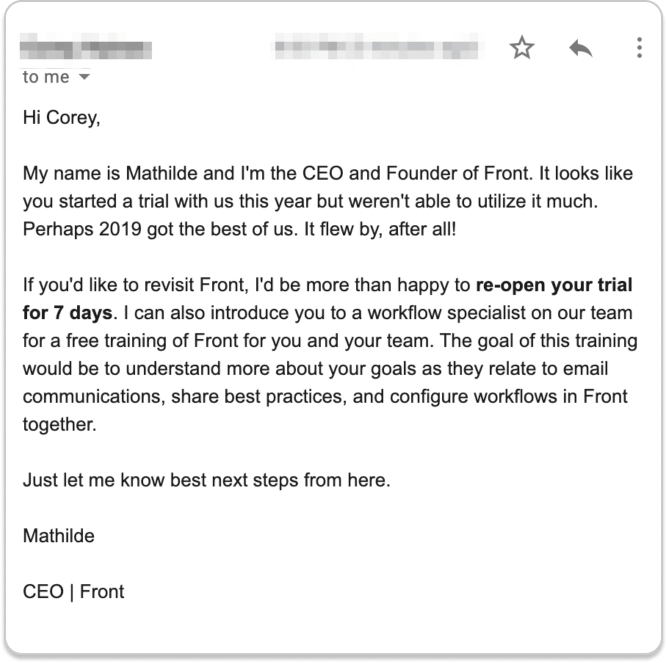
I believe this was sent out about six months after the original trial start. This is a tough cookie to crack because you've already had someone in the product they've already decided that they are not going to continue with you. It's going to be a hard one to reengage people and try to get some sort of tangible result.
Now I know that this worked pretty well because I had a few people on Twitter mention that this is what got them back into the product and reinvigorate their interest in the product itself. The high-level themes of what stands out is that it's written exactly like a hyper-personalized one to one personal email. Something I would send to you or you would send to me. Doesn't read like a kind of a corporate-y unbranded generic email.
She says things like, my name is Mathilde and I'm the CEO and founder. It sounds so funny to say now, but that's something that you would start with if you were sending to someone else, but most of these types of emails start with, "Hey, remember us?" or "Are you interested in trying Front again?" or something else like that. That immediately is the tale that, ah, well, this is just another thing about.. archive, right? Just kind of get rid of it.
That kind of theme of personality personalization is evident throughout it all. Then another big takeaway from the email is that there isn't a question mark or a call to action in the email.
She simply states what she would love to see back, which is a response. So she says, if you'd like to revisit Front, I'd be more than happy to reopen your trial for seven days. It doesn't say, would you like to reopen your trial? Or how can I get you to restart your trial? And at the end, it's the same thing, just letting me know what the best next steps are. It's not a, do you have five minutes tomorrow? That to me was a breath of fresh air.
Matthew Smith: I like the fact that she introduces herself. It says, looks like you weren't able to utilize it much. It's understanding. There's some empathy potentially. She's guessing, Mathilde is in this case or the email creator, but also I'd be happy, meaning I'd be willing to do this for you. I can do that. It has that sense, I'm going to do something for you instead of we'd do this or we're willing, or if you do this, we can do that. It's just interesting. Then I can also introduce you to a workflow specialist on our team for a free training.
So, Hey, maybe that was the thing. Maybe it was the lack of training that made me walk away from Front. It was too much, or it was felt overwhelming or something, but even further just to say the goal of this training. I think that's super interesting. They're talking about the purpose of the training.
What's happening is a lot of this email feels like it's more about me than Front and that's pretty unusual. I like that.
Corey Haines: Absolutely. I think, especially in a B2B setting where the calls to action are sort of high commitment. It's like sign up for something, pay us money, talk with one of us on the phone. When you orient it to the person that you're sending to and even when you would go as far to explain why you want them to take action on that thing that you want to do. The goal of this training would be an explanation. It comes off a lot more trustworthy, credible, empathetic, like you mentioned, and is an overall better experience.
Matthew Smith: Well, tell me what's happening in this one that you think is working well.
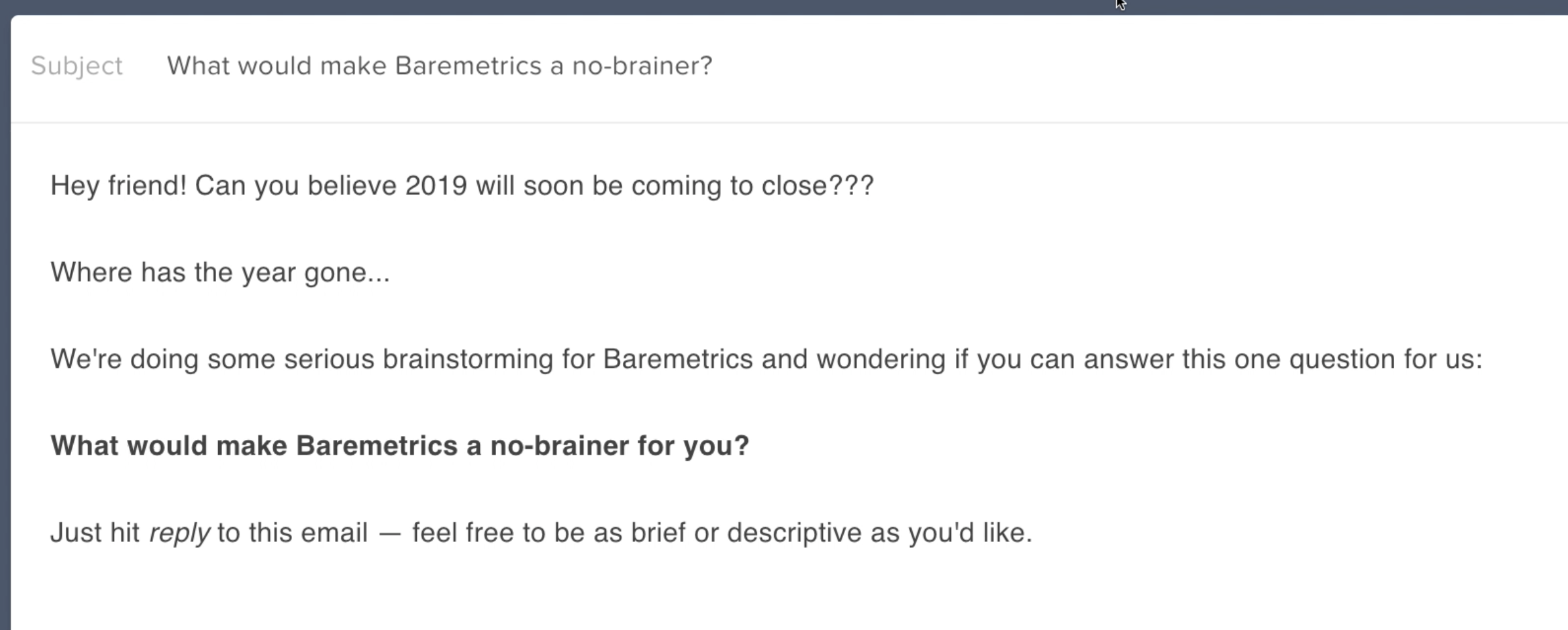
Corey Haines: This next one is an email that I sent out to canceled Baremetrics customers. Which is a segment that no one likes to talk about or wants to talk about, especially in the B2B world. I make a habit of every six months trying to send an email like this. It's very short, sweet to the point. It helps me understand what we can do, and if there's any opportunity for these people, since it's been a good amount of time.
It's funny because it follows a pretty similar pattern, but I had not seen the Front email before. What I wanted to do, my goals were to have a casual, personal style and intro. I wanted to give them context into why I'm emailing them. Then I wanted to flip the negative into a positive.
I know for a fact they canceled and we have a lot of feedback on why people cancel as well. So I didn't need to rehash that or open the can of worms again. Instead, I wanted to flip it to a positive. So instead of asking why they canceled or what we could do. Instead, I asked what would get them to stay or what would get them to come back.
So the main question that I ask is what would make Baremetrics a no brainer for you. It's not even what can I do to get you to sign up again? It's just, Hey yeah conceptually or theoretically, what would be valuable for you if it was Baremetrics or another tool, and then to have a really low commitment kind of call to action, low pressure.
Matthew Smith: I think it's working well. A question that I like to ask a lot of people is what would need to be true for XYZ to happen? It sort of follows that framework, right? What would need to change for Baremetrics to be like, Oh yeah, hell yeah? If it did this, or if I had that. And it reveals some interesting things.
I kind of love that it's all these five lines. I'm such a nit-picky designer that I can't even send like a text or an email to like a friend that way. It has to like be a nice little paragraph, has to fit very well. It has to be concise. It's kind of messy a little bit, and it makes it feel more personal or like personally written rather than automated.
You do this bolding and I think what you do there in some ways is a little bit like a tiny, tiny landing page. Hey. Here's this intro. Where has the year gone... Hey, here's what we're doing. Here's the real ask. Here's how to do something about it. It just makes sense. Did you have good responses from this?
Corey Haines: I can't remember exactly how many this got sent out to. It was in the thousands though because it was for all time too. I was doing some backlogging work. It got an 80% open rate and a 5% reply rate, which kept me busy for about two weeks. We had several people come back. Lots of good feedback, had some great conversations about our roadmap, and overall, even just kind of qualitatively, it felt like a successful email for us.
Matthew Smith: Love it. Now, what about this one from Zapier?

Corey Haines: So at the Zapier email, this is also fairly similar in that it's sort of a reactivation of some sort. In this case, it's more of like a usage reactivation. So Zapier is freemium. You can create a free account. But basically what's happened here is that someone started to create a "zap". A little automation, mini automation, but that they didn't finish it.
Now this email's goal is to get them to finish the "zap" and to actually "activate" as a user. What's interesting to me is that it's split into these three sections. You kind of know as well that this is not a personal email, but that's okay.
It still has a lot of great elements and it doesn't need to be a personal email for it to accomplish its goal. It starts with, Hey, it's Mike from Zapier personal and casual. He gives a quick explanation of what he thinks that you should do, and then provides a link to jump straight back into the "zap".
So many people, especially in B2B, they're like "log back in" or "get back to the dashboard" and I'm like, okay, well now I have to go through all the work of finding exactly what I was doing and especially for something like this, that was like the last step. If you can take someone directly to that step and eliminate all other kinds of friction and a work involved, it's going to be much more likely to happen.
Also, he includes these other sections on guided learning and a guide for step by step instructions in a written form. and then he says, Hey, if you have any questions, feel free to reach out to our support team. There's also a link to directly get in touch with the support team.
So it just feels like a care package. Here's everything that you need to get up and running and continue with your success with Zapier.
Matthew Smith: Yeah, that's interesting. Do you know anything about, the effect of the email? Did you ever hear from Zapier about that?
Corey Haines: I don't. No. I tried to poke around a little bit, again, this was actually from Twitter, from another friend who said, this is what got me back in and I'm so thankful that they sent this because I didn't even know that my "zap" wasn't turned on. They didn't realize that they didn't finish it. So again, kind of anecdotally there's some success, but no, I don't have any broad numbers.
Matthew Smith: Super interesting though. I like just anecdotally knowing that's what got somebody back in.
There are some things here in this email that are serving me, right? Like here's a link to jump back into your "zap". It's trying to create the lowest hanging bar for somebody to just return and bring them back in. Some people would call this a retention or a win-back campaign.
Keeping people guided about like how to do it, or if it's a little bit more like, Hey, I want some hands-on support then here's how to do that.
One thing that I like to say is like a good email or a good landing page, which I like to say that emails are landing pages delivered. You give people very clear, actionable steps, but you should sort of do it like a Bob Dylan song.
You know, like Bob Dylan, you can just jam out to good folk music. But if you get into it a little bit more and you can understand that it was very political or very spiritual. Those kinds of things. You want to make sure that you can just jam, you can get the quick thing first, and then you can dig in if that's your thing.
If I was independently wealthy, I would just test emails like this. I would send something out like this five or seven different ways and see what the results that you get on that. It would be fun to really do a very highly designed version of this with visual design or a much, much more text-oriented email without the sections and the bolding and the paragraphs, and try and really like shorten it up and see what seems to make it fit for that audience? Not like it works for all emails, but for that audience.
Corey Haines: One of the big takeaways for me as well for this type of email is also reminding someone of the value of what you're asking them to do. So in the very beginning, he says, Hey, it's Mike, you started your "zap", but you didn't quite finish it. Then he says, as soon as you turn on your "zap", we'll start automating your tasks in the background while you focus on more important work. It sounds nice. I think that's important because it's easy to forget why you're doing it in the first place or really what the value prop of the app was.
So now bringing it top of mind, I'm like, okay. Oh, you know what? It would be nice to automate this, forget about it, put it in the background then never have to get back to again. I'm just going to kind of bite the bullet and dig in. Whereas maybe if that was missing, if that wasn't in there and it was just like, here's what you should do, I wouldn't have the same context to understand why I should act now.
Matthew Smith: It makes it more about Zapier if they don't mention that. This makes it more about me or the receiver of the email. So many times our email marketing friends, they tend to send emails are all about themselves and not about the customer.
In relationships we call that narcissism, you know? So practice some empathy, practice a sense of you probably are busy as hell. Wouldn't it be nice to be able to focus on work again and let these things do the work for you that. You don't need to Oh yeah. I bet it would be nice.
To your point, this takes a minute to do, but it'll save you 10 minutes in the long run. Well, I appreciate you going through these with us. I recommend checking out Baremetrics and seeing what they're doing. Thank you for jumping in here with us Corey.
I appreciate it. It's fun to tackle a different topic and go after something that's not about design visually, but more about like copy and strategy and content.
Corey Haines: Thanks so much for having me. It's been fun. I love doing these types of things. I'm sort of a teardown aficionado. I do some tear-downs on the side for my self at swipefiles.co.
Some final takeaways for me, make it hyper-personal and have a voice that stands out from the unbranded generic kind of corporate jargon that you hear a lot of the times and then to orient to the customer, orient to the user. Frame everything in mind for them, the value that they're going to get, the struggles. Be empathetic.
I think if you have at least. Those two kind of core fundamental ingredients, any one of your emails are going to benefit from it.
Matthew Smith: Well dude happy Friday and everybody stay safe out there. Don't forget to subscribe to the channel so you can get updates and stay up to date on what we're doing. Check out baremetrics.com and swipefiles.co.
Thanks again, Corey. Have a great weekend, bro.
Corey Haines: Thank you. You too.
Matthew Smith: All right, ciao.
